|
The city of Antakya is
built on two sides of a river which, in the Biblical times was called
Orontos. Since the head waters of the river is in the south in Syria and
it flows north, the Turks call the river ASI "rebellious". St Peter
and St. Paul had started a big church here in Antakya ( Antioch) in around
48 AD. to differentiate the followers of Christ from the Gentiles, the
church members were called followers of Christ, Christian. So the name
which has been used for more than 2000 years had started here in this
city. At the museum we met the earliest followers of Christ.

They lived in the houses
which were beautifully adorned with great mosaic.
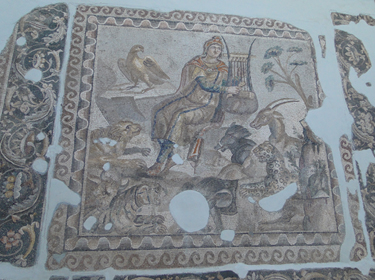
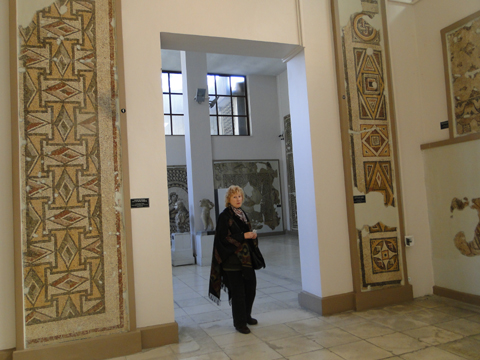
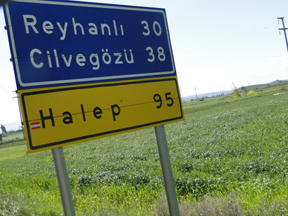 As
soon as we left Antakya , we found our selves in a very fertile valley,
Amik Ovasi, where vine yards, olive orchards, pepper fields popped out
from dark red soil. As we approached Syria, the
border runs through dry, rocky
land. Turkey protects its border with a fence and bales of coiled razor
wire. A few lonely soldiers are stationed along this barrier. We
arrived at the Turkish border. There was a long caravan of trucks
lined up waiting at the border. Our driver meandered through the
trucks and different gates and took us in the customs area. The Turkish
customs was easy. We al got our passports quickly stamped . We were now
all ready to roll in to Syria. Our first stop was the Turkey passport control for an
exit stamp, vying for our place with a long line of truck drivers waiting
to cross the border. Everyone made a pit stop not knowing how long we
might wait on the Syrian side before being allowed to enter. Usually there
is a bathrooms charge, but in this case we were literally held hostage by
three men and not allowed to exit the bathroom area until someone came up
with money --- and by the way, we also had to pay for Jim who managed to
sneak out without paying! As
soon as we left Antakya , we found our selves in a very fertile valley,
Amik Ovasi, where vine yards, olive orchards, pepper fields popped out
from dark red soil. As we approached Syria, the
border runs through dry, rocky
land. Turkey protects its border with a fence and bales of coiled razor
wire. A few lonely soldiers are stationed along this barrier. We
arrived at the Turkish border. There was a long caravan of trucks
lined up waiting at the border. Our driver meandered through the
trucks and different gates and took us in the customs area. The Turkish
customs was easy. We al got our passports quickly stamped . We were now
all ready to roll in to Syria. Our first stop was the Turkey passport control for an
exit stamp, vying for our place with a long line of truck drivers waiting
to cross the border. Everyone made a pit stop not knowing how long we
might wait on the Syrian side before being allowed to enter. Usually there
is a bathrooms charge, but in this case we were literally held hostage by
three men and not allowed to exit the bathroom area until someone came up
with money --- and by the way, we also had to pay for Jim who managed to
sneak out without paying!
| We hauled our
suitcases from the Turkey side to the Syrian side of the border.
Passport Control was a large white building with a special window
for tourist groups. After our passports were collected, we waited
anxiously on a bench inside. After nearly one hour, we moved outside
into the lovely sunshine. We were entertained by a worker pruning a
hedge to fit an arch above.
|
|
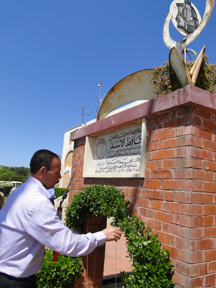 |
An important man dressed in a white shirt and slacks came out to review
the work. He
grabbed the hedge
trimmer and began showing the worker how it should be done. Several other
workers came to pick up the trimmings, and soon they made five.
The map of the
Arab world below the map of Syria was interesting. It was a good
reminder that not only we were stepping in Syria but we are now
going to be exposed to a complete different culture of the Semitic
world.
As we walked through the last check point I was wondering how
this borderless map will be fractured in to minute units of
"states". Iraq, Palestine, Libya, Syria are all going to be
decimated soon. |
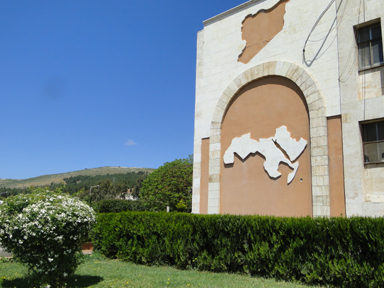 |
| We waited for our passports to be
"stamped" for about one hour.
No body in the group asked why it takes so long to stamp 8
passports. We were welcomed by our Syrian guide Aiman Ahmad Maliha
from Aleppo and bus driver Mohamed. Our great adventure to discover
the treasures of Syria had begun. |
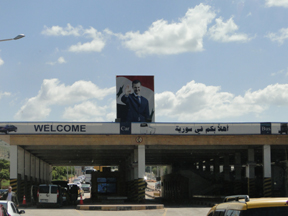 |
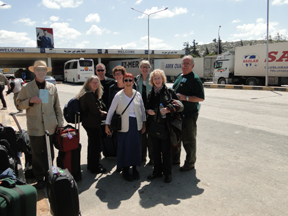 |
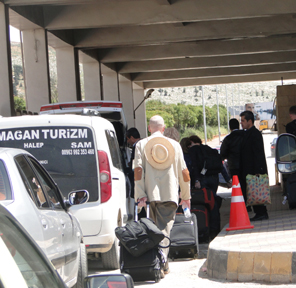
|
|
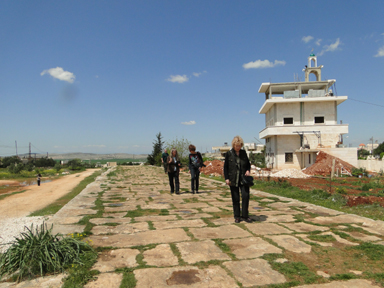 The first stop in Syria was the gate of
Havva, Eve. The Roman road which was the major military and trade
road for the Romans stretched in front of our eyes as great as it
must have been 2000 years ago. A very wide, well paved road must have been
trotted over by thousands of horse shoes and sandals for ages. We now had
our foot prints somewhere recorded in the history. The northern part of
Syria is the bread basket of the country. The land looked very fertile and
the villages looked prosperous with the beautiful stone houses. The
fields which were not cultivated yet were covered with yellow mustard
flowers and the red poppies. the scent in the air was fresh. The first stop in Syria was the gate of
Havva, Eve. The Roman road which was the major military and trade
road for the Romans stretched in front of our eyes as great as it
must have been 2000 years ago. A very wide, well paved road must have been
trotted over by thousands of horse shoes and sandals for ages. We now had
our foot prints somewhere recorded in the history. The northern part of
Syria is the bread basket of the country. The land looked very fertile and
the villages looked prosperous with the beautiful stone houses. The
fields which were not cultivated yet were covered with yellow mustard
flowers and the red poppies. the scent in the air was fresh.
Off the road to Aleppo,
we took a detour to visit the Monastery of St. Simon - the complex of
churches from the 5th century. This was a pilgrimage site where
St. Simeon, a “pillar saint,” held court. St Simeon was a curious
character. From an early age he appears to have displayed an aptitude for
self-inflicted pain. On entering the monastery at age 16, he wore a spiked
girdle that drew blood and spent his summers buried in the ground up to
his chin. Such odd behavior naturally attracted attention, so he perched
on a pillar to escape the crowds. The more crowds, the higher his pillar
grew, eventually reaching 64 feet. The Basilica has four naves, and in the
center is the pillar stump which is all that remains of the pillar. The
church is a masterpiece of early Christian architecture and is one of the
largest churches ever built. It held up to 10,000 worshippers. We took a
break at a small cafe near the entry and enjoyed fresh-squeezed orange
juice and tea under spreading pines. A sweet but flea-bitten dog with
chewed-up ears looked at us hopefully. He had a penchant for chewing on
our shoes.
|
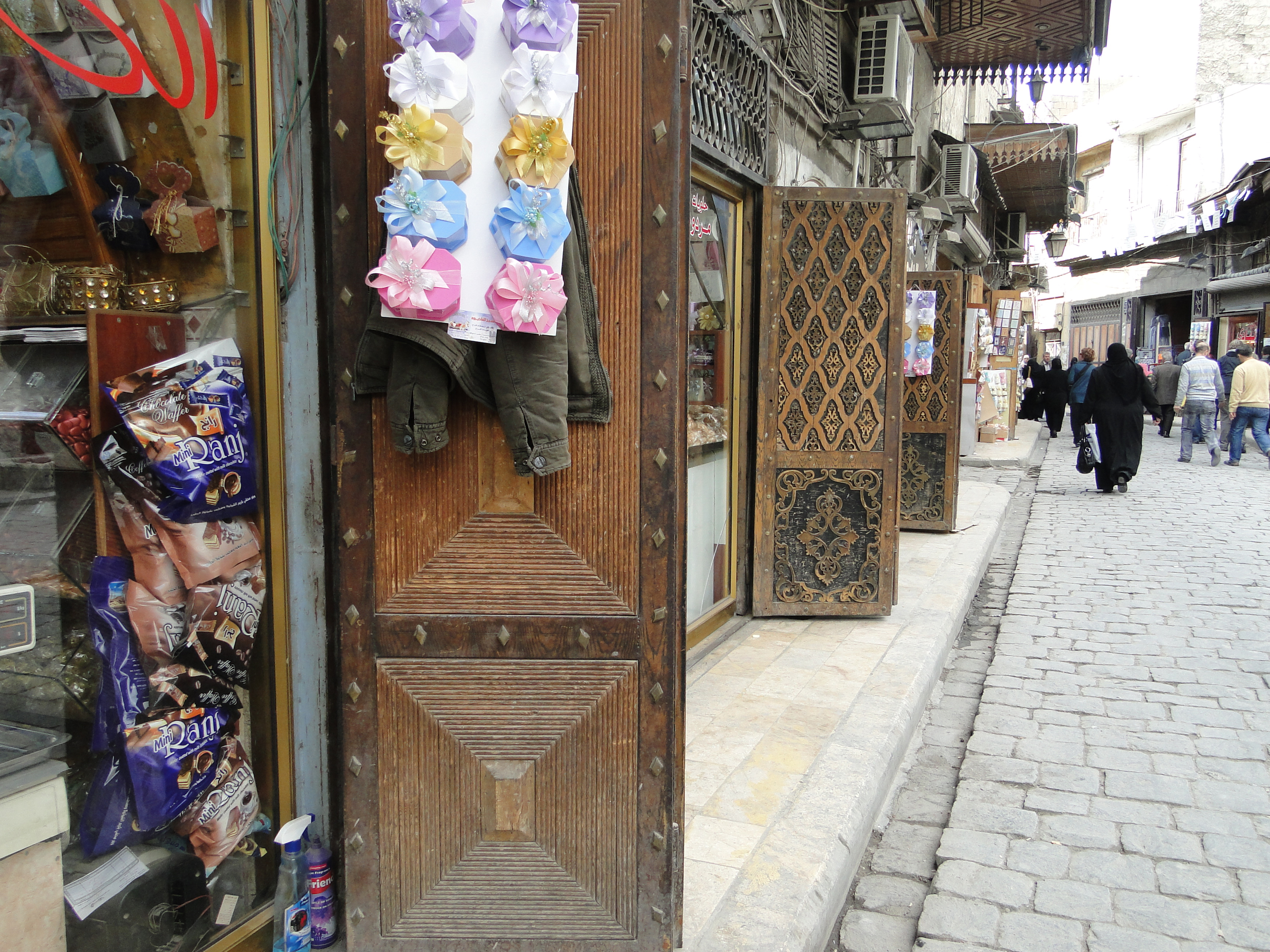 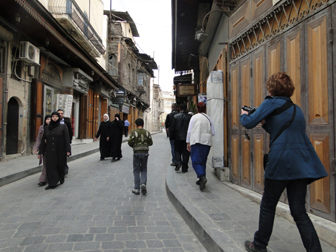 We entered Aleppo also known as Halep near the Antakia
gate. Legend has it that Abraham milked his cow at the top of the imposing
citadel. We were introduced to Aleppo with a walk around the old town,
through narrow streets lined with small shops selling candy bags of all
shapes and sizes, women’s handbags, scarves and other items. We had lunch at Sissi House, a large old house with an
open courtyard and several stories of rooms on each side. We started with
a selection of mezes followed by a mixed kebab platter, and dessert. It
was a fantastic lunch – we did not need to eat for a week! We entered Aleppo also known as Halep near the Antakia
gate. Legend has it that Abraham milked his cow at the top of the imposing
citadel. We were introduced to Aleppo with a walk around the old town,
through narrow streets lined with small shops selling candy bags of all
shapes and sizes, women’s handbags, scarves and other items. We had lunch at Sissi House, a large old house with an
open courtyard and several stories of rooms on each side. We started with
a selection of mezes followed by a mixed kebab platter, and dessert. It
was a fantastic lunch – we did not need to eat for a week!
�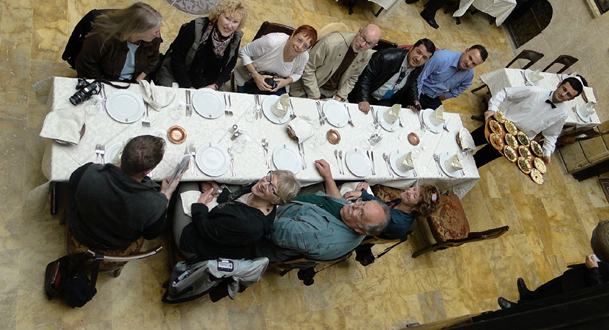
Nearby was a Greek Orthodox church with interesting
iconography. In the same quarter was the Armenian church of Saint Forty
Martyrs. A fervent young Armenian cleric offered us a tour. He began by
telling us how the Ottomans slaughtered his grandfather and that he hates
the Ottomans. The question was posed as to how the Turks differed from the
Ottomans. He was quite agitated as he told this story. Ultimately, he
admitted he hated the Turks. His agitation pervaded the tour of the
church, and he made much of all the art showing the suffering of the
people. He showed us a painting from the school of Leonardo and the
suckling Jesus. We were happy it was the end of the day and we could slip
away.
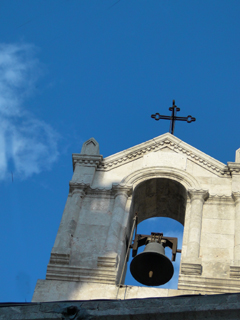
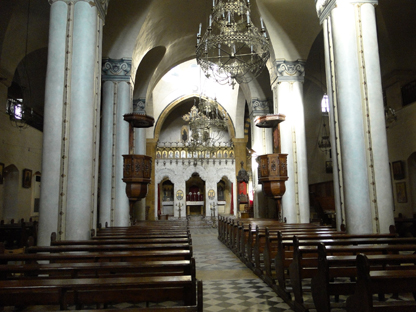
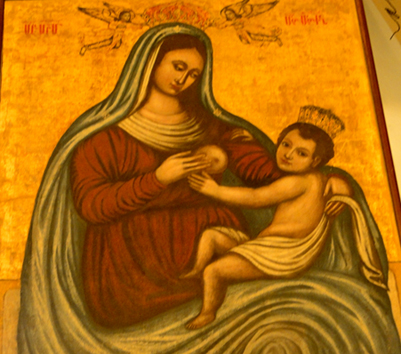
We headed to the hotel at the base of the citadel.
Wandering up a narrow street, we arrived at the large brass door of Beit
Salahieh. The hotel, was once an old house, totally restored with fabulous
rooms, some with large stone tubs, wood paneling and large windows. We’ve
seen few tourists (2) and relish the quiet of our Aleppo hideaway.
Nearby was a Greek Catholic church with interesting
iconography. In the same quarter was the Armenian church of Saint Forty
Martyrs. A fervent young Armenian
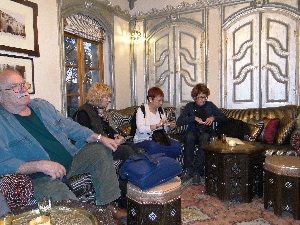 cleric
offered us a tour. He began by telling us how the Ottomans slaughtered his
grandfather and that he hates the Ottomans. He was quite agitated as he
told this story. The question was posed as to how the Turks differed from
the Ottomans. Ultimately, he admitted he hated the Turks. His
agitation pervaded the tour of the church, and he made much of all the art
showing the suffering of the people. He showed us a painting from the
school of Leonardo and the suckling Jesus. We were happy it was the end of
the day and we could slip away. cleric
offered us a tour. He began by telling us how the Ottomans slaughtered his
grandfather and that he hates the Ottomans. He was quite agitated as he
told this story. The question was posed as to how the Turks differed from
the Ottomans. Ultimately, he admitted he hated the Turks. His
agitation pervaded the tour of the church, and he made much of all the art
showing the suffering of the people. He showed us a painting from the
school of Leonardo and the suckling Jesus. We were happy it was the end of
the day and we could slip away.
We headed to the hotel at the base of the citadel.
Wandering up a narrow street, we arrived at the large brass door of Beit
Salahieh. The hotel, was once an old house, totally restored with fabulous
rooms, some with large stone tubs, wood paneling and large windows. We’ve
seen few tourists (2) and relish the quiet of our Aleppo hideaway.
Click here for Day 2 in Syria - Aleppo
Table of Content Syria tour Itinerary
Home page
Syria 2011 group journal
|
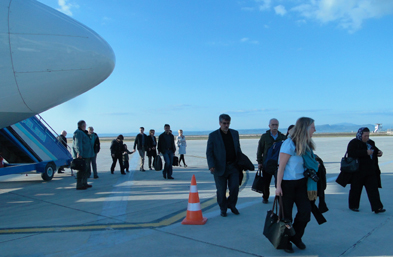
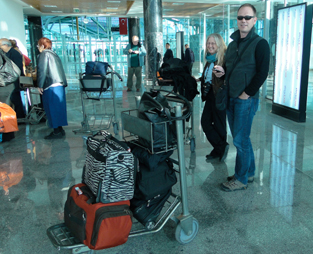



 As
soon as we left Antakya , we found our selves in a very fertile valley,
Amik Ovasi, where vine yards, olive orchards, pepper fields popped out
from dark red soil. As we approached Syria, the
border runs through dry, rocky
land. Turkey protects its border with a fence and bales of coiled razor
wire. A few lonely soldiers are stationed along this barrier. We
arrived at the Turkish border. There was a long caravan of trucks
lined up waiting at the border. Our driver meandered through the
trucks and different gates and took us in the customs area. The Turkish
customs was easy. We al got our passports quickly stamped . We were now
all ready to roll in to Syria. Our first stop was the Turkey passport control for an
exit stamp, vying for our place with a long line of truck drivers waiting
to cross the border. Everyone made a pit stop not knowing how long we
might wait on the Syrian side before being allowed to enter. Usually there
is a bathrooms charge, but in this case we were literally held hostage by
three men and not allowed to exit the bathroom area until someone came up
with money --- and by the way, we also had to pay for Jim who managed to
sneak out without paying!
As
soon as we left Antakya , we found our selves in a very fertile valley,
Amik Ovasi, where vine yards, olive orchards, pepper fields popped out
from dark red soil. As we approached Syria, the
border runs through dry, rocky
land. Turkey protects its border with a fence and bales of coiled razor
wire. A few lonely soldiers are stationed along this barrier. We
arrived at the Turkish border. There was a long caravan of trucks
lined up waiting at the border. Our driver meandered through the
trucks and different gates and took us in the customs area. The Turkish
customs was easy. We al got our passports quickly stamped . We were now
all ready to roll in to Syria. Our first stop was the Turkey passport control for an
exit stamp, vying for our place with a long line of truck drivers waiting
to cross the border. Everyone made a pit stop not knowing how long we
might wait on the Syrian side before being allowed to enter. Usually there
is a bathrooms charge, but in this case we were literally held hostage by
three men and not allowed to exit the bathroom area until someone came up
with money --- and by the way, we also had to pay for Jim who managed to
sneak out without paying!




 The first stop in Syria was the gate of
Havva, Eve. The Roman road which was the major military and trade
road for the Romans stretched in front of our eyes as great as it
must have been 2000 years ago. A very wide, well paved road must have been
trotted over by thousands of horse shoes and sandals for ages. We now had
our foot prints somewhere recorded in the history. The northern part of
Syria is the bread basket of the country. The land looked very fertile and
the villages looked prosperous with the beautiful stone houses. The
fields which were not cultivated yet were covered with yellow mustard
flowers and the red poppies. the scent in the air was fresh.
The first stop in Syria was the gate of
Havva, Eve. The Roman road which was the major military and trade
road for the Romans stretched in front of our eyes as great as it
must have been 2000 years ago. A very wide, well paved road must have been
trotted over by thousands of horse shoes and sandals for ages. We now had
our foot prints somewhere recorded in the history. The northern part of
Syria is the bread basket of the country. The land looked very fertile and
the villages looked prosperous with the beautiful stone houses. The
fields which were not cultivated yet were covered with yellow mustard
flowers and the red poppies. the scent in the air was fresh. 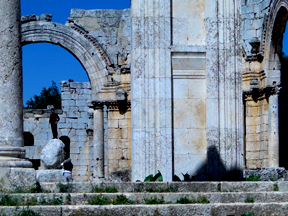
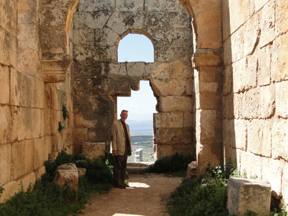
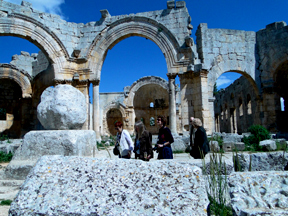
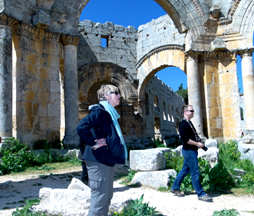

 We entered Aleppo also known as Halep near the Antakia
gate. Legend has it that Abraham milked his cow at the top of the imposing
citadel. We were introduced to Aleppo with a walk around the old town,
through narrow streets lined with small shops selling candy bags of all
shapes and sizes, women’s handbags, scarves and other items. We had lunch at Sissi House, a large old house with an
open courtyard and several stories of rooms on each side. We started with
a selection of mezes followed by a mixed kebab platter, and dessert. It
was a fantastic lunch – we did not need to eat for a week!
We entered Aleppo also known as Halep near the Antakia
gate. Legend has it that Abraham milked his cow at the top of the imposing
citadel. We were introduced to Aleppo with a walk around the old town,
through narrow streets lined with small shops selling candy bags of all
shapes and sizes, women’s handbags, scarves and other items. We had lunch at Sissi House, a large old house with an
open courtyard and several stories of rooms on each side. We started with
a selection of mezes followed by a mixed kebab platter, and dessert. It
was a fantastic lunch – we did not need to eat for a week!



 cleric
offered us a tour. He began by telling us how the Ottomans slaughtered his
grandfather and that he hates the Ottomans. He was quite agitated as he
told this story. The question was posed as to how the Turks differed from
the Ottomans. Ultimately, he admitted he hated the Turks. His
agitation pervaded the tour of the church, and he made much of all the art
showing the suffering of the people. He showed us a painting from the
school of Leonardo and the suckling Jesus. We were happy it was the end of
the day and we could slip away.
cleric
offered us a tour. He began by telling us how the Ottomans slaughtered his
grandfather and that he hates the Ottomans. He was quite agitated as he
told this story. The question was posed as to how the Turks differed from
the Ottomans. Ultimately, he admitted he hated the Turks. His
agitation pervaded the tour of the church, and he made much of all the art
showing the suffering of the people. He showed us a painting from the
school of Leonardo and the suckling Jesus. We were happy it was the end of
the day and we could slip away.